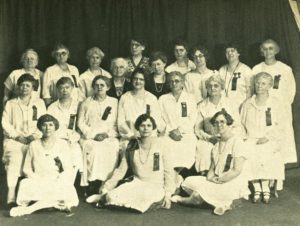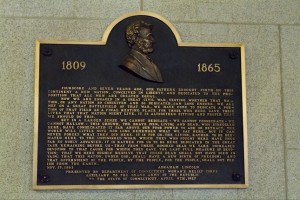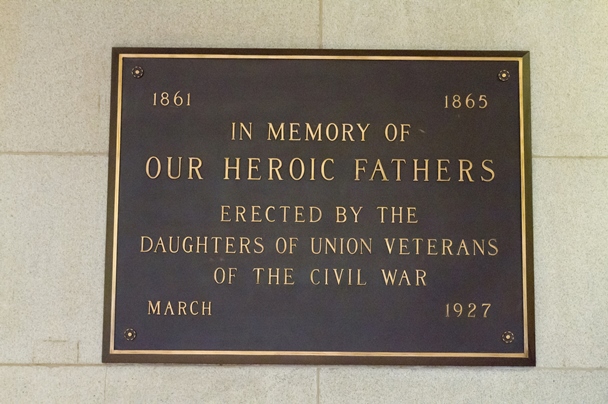By Amanda Nicolas
Hidden behind the Prudence Crandall monument in the state capitol’s southern entrance are two large bronze plaques. The plaques were erected in 1927 to counter the declining perception of Union women’s patriotism and dedicated separately due to a half-century-long rivalry.
The two plaques, or bronze tablets, were dedicated on April 9, 1927, to celebrate the 62nd anniversary of the Confederate surrender at Appomattox Courthouse. The first tablet lauded the dedication of “Our Heroic Fathers” who fought in the Civil War, and was designed, purchased, and erected by the Daughters of Union Veterans (DUV). Although labeled as installed in March of 1927, this monument was not formally unveiled until April 9th of that year. The second plaque commemorated President Abraham Lincoln and his famous Gettysburg Address. This plaque was constructed and paid for by the Woman’s Relief Corps (WRC).
Two Groups, Two Tablets

Group photograph of the 1927 elected officials of the Connecticut’s Woman’s Relief Corps – Connecticut State Library, State Archives
To a modern observer, these two groups appear incredibly similar in their membership and volunteer efforts, but were still fiercely divided decades after the real battles ended. The WRC began in Massachusetts as a “secret association” in 1879, because female membership to the larger Grand Army of the Republic (GAR), a Union veterans group, had been repeatedly denied. Other states began their own WRCs and were eventually included in the GAR as auxiliary groups.
The WRC was open to any patriotic American woman who wished to help surviving Union veterans and their families. Caroline Janney, in her book, Remembering the Civil War: Reunion and the Limits of Reconciliation, described the WRC’s intention to include all loyal women: “Should not a woman who had served as a nurse, whether or not the daughter or wife of a Union solider, be allowed to show her continued patriotism? And what about the woman who had folded away her wedding garments and sent her sweetheart off to war before they could wed?” In 1884, national WRC president, E. Florence Barker, stated that “not all loyal men were soldiers, not every loyal woman a soldier’s wife.”
Many mothers, wives, and daughters of Union veterans vehemently objected to the liberal membership policies of the WRC and began their own groups shortly after. They maintained strict guidelines for membership and asked that applicants show their direct relation to a Union soldier. Fifty years later, in 1927, this divide continued as the WRC and DUV held separate ceremonies for the dedication of two different plaques in Connecticut’s state capitol.
The Cost and Construction of the Tablets

Bronze tablet dedicated to President Abraham Lincoln and his Gettysburg Address by the Woman’s Relief Corps on April 9, 1927 – Courtesy of Stacey Renee
There is more information available regarding the WRC’s tablet because the Connecticut state archive holds many of their annual journals. The Lincoln and Gettysburg address memorial was manufactured in Cincinnati, Ohio, by the Newman Manufacturing Co. for $80 in March of 1927. In April, the WRC paid an additional $34.50 for President Eleanor Lucy’s expenses and to expedite the creation of their plaque. In addition, they hired the G. Enders & Co., New England Construction Co. for $15 to set the tablet, and Sadie Gooley for $10 to sing at the dedication. All told, the plaque and ceremony cost the WRC $139.50. In 2013, this cost would be approximately $1,885. Although we do not know how much the DUV tablet cost, it is the exact same size and similar design to the WRC’s tablet and probably cost a similar amount.
Ceremonies and Attendees
On April 9, 1927, at 10:30 in the morning, the ceremonies began with the dedication of the Connecticut WRC’s bronze tablet commemorating President Lincoln and the Gettysburg Address. A crowd of approximately one hundred spectators (including a number of Civil War veterans in full uniform) attended both ceremonies, and as the Hartford Courant noted, “gave their familiar cheer for the women who have supported them in their work.” Introduced by Colonel Ira Wildman, chief-of-staff for the Connecticut GAR, both tablets were formally accepted by Lieutenant Governor J. Edwin Brainard. In his remarks, Colonel Wildman lauded “the part women had always played in times of national emergency, and the work being done by Connecticut women to keep alive the memory of Connecticut men who fought in the Civil War.”
There was a last-minute change to the arranged ceremonies, however, as President Eleanor L. Lucy fell ill a short time before and Mrs. Maud Smith Deming, the WRC vice-president, took her place and gave the remarks. Immediately following, Mrs. May F. Odgen unveiled the plaque, while Mrs. Myrtle Case presented the monument to the public. In her speech, Case remarked, “I take great pleasure in presenting to our dear old Nutmeg State, through you, this tablet, inscribed with Lincoln’s Gettysburg Address, as a memorial to the Connecticut Grand Army of the Republic. May it endure for all time; may it prove an inspiration for a higher ideal of patriotism, for a deeper love of country; and may it especially serve as a reminder forever that this State which they so nobly defended, is not ungrateful, is not forgetful of ‘those comrades, brave and true, who fought and save “Old Glory,” in their uniforms of blue.’”
Mrs. Sadie Gooley, a professional soloist, sang “Battle Hymn of the Republic” and James R. Young, department commander at the GAR post in Danbury, thrilled the crowd with a description of the Battle of Gettysburg and Lincoln’s famous speech. The WRC concluded their celebration with a prayer by GAR department chaplain Henry W. Burrill, followed by “My Country ‘Tis of Thee” sung in unison by all in attendance.
An hour later, the Daughters of Union Veterans dedicated their bronze tablet, honoring “Our Heroic Fathers.” Reverend John Henry Bell, Pastor of the South Park Methodist Church in Hartford, opened with a prayer and briefly recounted the memorable surrender at Appomattox Courthouse which he claimed “represented one of the greatest in the country’s history.” Mrs. Mary E. Yale, president of the DUV, presented the bronze tablet while Miss Gladys Nichols Tracy unveiled it. Finally, Reverend Warren S. Archibald, Pastor at the South Congregational Church in Hartford, delivered the keynote speech, remarking, “It is only by the sympathy of the heart, joined with the understanding of the head that will make us forever one people.”
Monuments as Part of a Movement
Both the DUV and WRC faced the ongoing perception that Union women were not as patriotic as their Confederate counterparts. As Janney described, “Despite their volunteer activities, the distance between the battlefront and the home front meant that northern women were often perceived by Union soldiers, the northern press, and even other women as indifferent to the war effort. The fact that they did not endure the tightening blockade meant they did not have to confine themselves to two meals a day or forego luxury clothing as some had urged. Moreover, unlike Confederate women, northern women had fewer opportunities to display acts of defiance against enemy soldiers.” Within the next decade, the members of the DUV and WRC would witness the nation embrace Confederate women’s patriotism with the success of the 1930s book, and later film, Gone with the Wind.
Connecticut boasts at least one additional WRC monument that shows the tablet in Hartford was not a singular effort by the organization. On August 26, 1923, the WRC erected a monument in Evergreen Cemetery in Stonington, Connecticut, dedicated to, “THE BRAVE SONS OF STONINGTON – WHO FOUGHT IN THE WAR OF – 1861 – 1865.” Union women, separated by their ideas on patriotic membership, used these monuments to counter national perceptions that the victorious women were less passionate about their cause than their rebel sisters.
Amanda Nicholas, a native of Nantucket, is a public history graduate student at Central Connecticut State University, while working full time at Mystic Seaport: The Museum of America and the Sea, and indulging in her favorite pastimes: historical research, knitting, and blacksmithing.
This article was published as part of a semester-long graduate student project at Central Connecticut State University that examined Civil War monuments and their histories in and around the State Capitol in Hartford, Connecticut.
<< Previous – Home – Next >>









